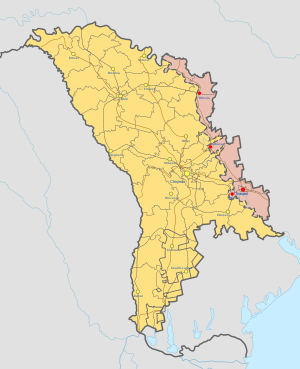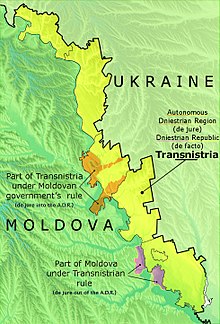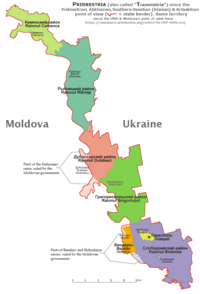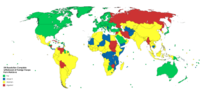Transnistria conflict
This article has multiple issues. Please help improve it or discuss these issues on the talk page. (Learn how and when to remove these template messages)
|
| Transnistria conflict | |||||||||
|---|---|---|---|---|---|---|---|---|---|
| Part of the post-Soviet conflicts | |||||||||
 Moldova Transnistria | |||||||||
| |||||||||
| Belligerents | |||||||||
Template:Campaignbox Transnistria conflict
 |
|---|
| Constitution |
The Transnistria conflict (Romanian: Conflictul din Transnistria; Russian: Приднестровский конфликт, romanized: Pridnestrovskiy konflikt) is an ongoing frozen conflict between Moldova and the unrecognized state of Transnistria. Its most active phase was the Transnistria War. There have been several attempts to resolve the conflict, although none have been successful.[9][10] The conflict may be considered as having started on 2 September 1990, when Transnistria made a formal sovereignty declaration from Moldova (then part of the Soviet Union).[11]
The Transnistria is internationally recognised as a part of Moldova. It obtained diplomatic recognition only from three post-Soviet unrecognized states: Abkhazia, South Ossetia and Artsakh.
Historical status of Transnistria


Until the Second World War
The Soviet Union in the 1930s had an autonomous region of Transnistria inside Ukraine, called the Moldavian Autonomous Soviet Socialist Republic (MASSR), where nearly half of the population were Romanian-speaking people, and with Tiraspol as its capital.[citation needed]
During World War II, when Romania, aided by Nazi Germany, took control of Transnistria, it did not attempt to annex the occupied territory during the war, although it had plans to do so in the future.[12][13]
Territorial consequences of the 1992 conflict
Left bank of the Dniester
During the War of Transnistria, some villages in the central part of Transnistria (on the eastern bank of the Dniester), rebelled against the new separatist Transnistria (PMR) authorities. They have been under effective Moldovan control as a consequence of their rebellion against the PMR. These localities are: commune Cocieri (including village Vasilievca), commune Molovata Nouă (including village Roghi), commune Corjova (including village Mahala), commune Coșnița (including village Pohrebea), commune Pîrîta, and commune Doroțcaia. The village of Corjova is in fact divided between PMR and Moldovan central government areas of control. Roghi is also controlled by the PMR authorities.[citation needed]
Right bank of the Dniester
At the same time, some areas which are situated on the right bank of the Dniester are under PMR control. These areas consist of the city of Bender with its suburb Proteagailovca, the communes Gîsca, Chițcani (including villages Mereneşti and Zahorna), and the commune of Cremenciug, formally[clarification needed] in the Căușeni District, situated south of the city of Bender.[citation needed]
The breakaway PMR authorities also claim the communes of Varnița, in the Anenii Noi District, a northern suburb of Bender, and Copanca, in the Căușeni District, south of Chițcani, but these villages remain under Moldovan control.[citation needed]
Later tensions
Several disputes have arisen from these cross-river territories. In 2005, PMR Militia entered Vasilievca, which is located over the strategic road linking Tiraspol and Rîbnița, but withdrew after a few days.[14][15] In 2006 there were tensions around Varnița. In 2007 there was a confrontation between Moldovan and PMR forces in the Dubăsari-Cocieri area; however, there were no casualties. On 13 May 2007, the mayor of the village of Corjova, which is under Moldovan control, was arrested by the PMR militsia (police) together with a councilor of Moldovan-controlled part of the Dubăsari district.[16]
Amid increased tensions between Russia and Ukraine, on 14 January 2022 Ukrainian military intelligence declared that Russian special services were preparing "provocations" against Russian soldiers present in Transnistria at the time to create a pretext for a Russian invasion of Ukraine.[17]
Position of the PMR government advocates
According to PMR advocates, the territory to the east of the Dniester River never belonged either to Romania, nor to its predecessors, such as the Principality of Moldavia. This territory was split off from the Ukrainian SSR in a political maneuver of the USSR to become a seed of the Moldavian SSR (in a manner similar to the creation of the Karelo-Finnish SSR). In 1990, the Pridnestrovian Moldavian SSR was proclaimed in the region by a number of conservative local Soviet officials opposed to perestroika. This action was immediately declared void by the then General Secretary of the Communist Party of the Soviet Union Mikhail Gorbachev.[18]
At the dissolution of the Soviet Union in 1991, Moldova became independent. The Moldovan Declaration of Independence denounced the Molotov–Ribbentrop Pact and declared the 2 August 1940 "Law of the USSR on the establishment of the Moldavian SSR" null and void. The PMR side argues that, since this law was the only legislative document binding Transnistria to Moldova, there is neither historical nor legal basis for Moldova's claims over the territories on the left bank of the Dniester.[19]
A 2010, study conducted by the University of Colorado Boulder showed that the majority of Transnistria's population supports the country's separation from Moldova. According to the study, more than 80% of ethnic Russians and Ukrainians, and 60% of ethnic Moldovans in Transnistria preferred independence or annexation by Russia rather than reunification with Moldova.[20]
In 2006, officials of the country decided to hold a referendum to determine the status of Transnistria. There were two statements on the ballot: the first one was, "Renunciation of independence and potential future integration into Moldova"; the second was, "Independence and potential future integration into Russia". The results of this double referendum were that a large section of the population was against the first statement (96.61%)[21] and in favor of the second one (98.07%).[22]
Moldovan position
Moldova lost de facto control of Transnistria in 1992, in the wake of the War of Transnistria. However, the Republic of Moldova considers itself the rightful successor state to the Moldavian SSR (which was guaranteed the right to secession from the Soviet Union under the last version of the Soviet Constitution). By the principle of territorial integrity, Moldova claims that any form of secession from the state without the consent of the central Moldovan government is illegal.[citation needed] The Moldavian side hence believes that its position is backed by international law.[23]
It considers the current Transnistria-based PMR government to be illegitimate and not the rightful representative of the region's population, which has a Moldovan plurality (39.9% as of 1989).[24] The Moldovan side insists that Transnistria cannot exist as an independent political entity and must be reintegrated into Moldova.[citation needed]
According to Moldovan sources, the political climate in Transnistria does not allow the free expression of the will of the people of the region and supporters of reintegration of Transnistria in Moldova are subjected to harassment, arbitrary arrests and other types of intimidation from separatist authorities.[citation needed]
Because of the non-recognition of Transnistria's independence, Moldova believes that all inhabitants of Transnistria are legally speaking, citizens of Moldova. However, it is estimated that 60,000 to 80,000 inhabitants of Transnistria acquired Russian citizenship[25] and around 20,000 Transnistrians have acquired Ukrainian citizenship. As a result, Moldovan authorities have tried to block the installation of a Russian and Ukrainian consulate in Tiraspol.[25]
International recognition of the sovereignty of Transnistria
Only three polities recognize Transnistria's sovereignty, which are themselves largely unrecognized states: Abkhazia, South Ossetia and Artsakh. All four states are members of the Community for Democracy and Rights of Nations.
United Nations Resolution A/72/L.58

On 22 June 2018, the Republic of Moldova submitted a UN resolution that calls for "Complete and unconditional withdrawal of foreign military forces from the territory of the Republic of Moldova, including Transnistria." The resolution was adopted by a simple majority.[26]
See also
- Four Pillars of Transnistria
- War of Transnistria
- 2006 Transnistrian customs crisis
- International recognition of Transnistria
- Foreign relations of Transnistria
- Abkhaz–Georgian conflict
- Georgian–Ossetian conflict
- Nagorno-Karabakh conflict
References
- ^ Adam, Vlad (2017). Romanian involvement in the Transnistrian War (Thesis). Leiden University. pp. 1–31.
- ^ "Iohannis: Națiunile Unite nu trebuie să tolereze conflictul din Transnistria". Agora (in Romanian). 29 September 2015.
- ^ "Ukraine's stance on Transnistria remains unchanged – Zelensky". Ukrinform. 12 January 2021.
- ^ "Ukraine helps Moldova regain control over border in Transnistrian region". Euromaidan Press. 21 July 2017.
- ^ Ioniță, Tudor (27 April 2022). "VIDEO // Arestovici: Ucraina poate rezolva problema transnistreană "cât ai pocni din degete", dar trebuie ca R. Moldova să-i ceară ajutorul". Deschide.MD (in Romanian).
- ^ O'Reilly, Kieran; Higgins, Noelle (2008). "The role of the Russian Federation in the Pridnestrovian conflict: an international humanitarian law perspective". Irish Studies in International Affairs. 19. Royal Irish Academy: 57–72. doi:10.3318/ISIA.2008.19.57. JSTOR 25469836. S2CID 154866746.
- ^ Munteanu, Anatol (2020). "The hybrid warfare triggered by Russian Federation in the Republic of Moldova". Editura Academiei Oamenilor de Știință din România. 12 (1): 129–162.
- ^ "Russia defends "peacekeepers" the new Moldovan president wants out". Polygraph.info. 7 December 2020.
- ^ Cojocaru, Natalia (2006). "Nationalism and identity in Transnistria". Innovation: The European Journal of Social Science Research. 19 (3–4): 261–272. doi:10.1080/13511610601029813. S2CID 53474094.
- ^ Roper, Steven D. (2001). "Regionalism in Moldova: the case of Transnistria and Gagauzia". Regional & Federal Studies. 11 (3): 101–122. doi:10.1080/714004699. S2CID 154516934.
- ^ Blakkisrud, Helge; Kolstø, Pål (2013). "From secessionist conflict toward a functioning state: processes of state- and nation-building in Transnistria". Post-Soviet Affairs. 27 (2): 178–210. doi:10.2747/1060-586X.27.2.178. S2CID 143862872.
- ^ Charles King: "The Moldovans", Hoover Institution Press, Stanford, California, 1999, page 93
- ^ Memoirs of Gherman Pântea, mayor of Odessa 1941–1944, in ANR-DAIC, d.6
- ^ "Moldova Azi". Archived from the original on 14 May 2006. Retrieved 23 December 2006.
- ^ "Locuitorii satului Vasilievca de pe malul stâng al Nistrului trăiesc clipe de coșmar". Archived from the original on 18 March 2005. Retrieved 20 January 2007.
- ^ "Ineffectiveness of peacekeeping mechanism leads to incidents in Moldova's Security Zone". Archived from the original on 27 September 2007. Retrieved 8 February 2016.
- ^ "Russia is preparing a pretext for invading Ukraine: US official". Al Jazeera English. 14 January 2022.
- ^ "UN and OSCE: Pridnestrovie is "different" and "distinct"". Archived from the original on 27 September 2010. Retrieved 18 September 2010.
- ^ "Moldova: "null and void" merging with Pridnestrovie". Archived from the original on 17 June 2007. Retrieved 18 September 2010.
- ^ "How people in South Ossetia, Abkhazia and Transnistria feel about annexation by Russia". Washington Post. Retrieved 17 December 2016.
- ^ ch, Beat Müller, beat (at-sign) sudd (dot). "Transnistrische Moldawische Republik (Moldawien), 17. September 2006 : Verzicht auf Unabhängigkeit – [in German]". www.sudd.ch. Retrieved 15 May 2020.
{{cite web}}: CS1 maint: multiple names: authors list (link) - ^ ch, Beat Müller, beat (at-sign) sudd (dot). "Transnistrische Moldawische Republik (Moldawien), 17. September 2006 : Unabhängigkeitskurs und Beitritt zu Russland – [in German]". www.sudd.ch. Retrieved 15 May 2020.
{{cite web}}: CS1 maint: multiple names: authors list (link) - ^ "Looking for a Solution Under International Law for the Moldova – Transnistria Conflict". Opinio Juris. 17 March 2020. Retrieved 15 May 2020.
- ^ Refugees, United Nations High Commissioner for. "Refworld | World Directory of Minorities and Indigenous Peoples – Transnistria (unrecognised state)". Refworld. Retrieved 15 May 2020.
- ^ a b Refugees, United Nations High Commissioner for. "Refworld | Moldova and Russia: Whether a holder of Ukrainian citizenship, born in Tiraspol, could return to Tiraspol and acquire Russian citizenship (2005)". Refworld. Retrieved 15 May 2020.
- ^ "General Assembly of the United Nations". www.un.org. Retrieved 15 October 2020.
Bibliography
- Oleksandr Pavliuk, Ivanna Klympush-Tsintsadze (2004). The Black Sea Region: Cooperation and Security Building. EastWest Institute. ISBN 0-7656-1225-9.
- Janusz Bugajski (2002). Toward an Understanding of Russia: New European Perspectives. p. 102. ISBN 0-87609-310-1.
- "Transnistria: alegeri nerecunoscute". Ziua. 13 December 2005. Archived from the original on 30 June 2006.
- James Hughes; Gwendolyn Sasse, eds. (2002). Ethnicity and Territory in the Former Soviet Union: Regions in conflict. Routledge Ed. ISBN 0-7146-5226-1.
External links
- Transnistrian side
- History of creation and development of the Parliament of the Pridnestrovian Moldavian Republic (PMR)
- Moldovan side
- EuroJournal.org's Transnistria category
- Trilateral Plan for Solving the Transnistrian Issue (developed by Moldova-Ukraine-Romania expert group)
- Others
- International organizations
- OSCE Mission to Moldova: Conflict resolution and negotiation category
- Marius Vahl and Michael Emerson, "Moldova and the Transnistrian Conflict" (pdf) in "Europeanization and Conflict Resolution: Case Studies from the European Periphery", JEMIE – Journal on Ethnopolitics and Minority Issues in Europe, 1/2004, Ghent, Belgium
- Research on the European Union and the conflict in Transnistria
- New York City Bar: Russia’s Activities in Moldova Violate International Law
- Ukrainian side
- Romanian side

